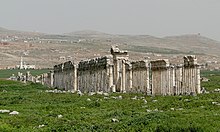Apamea, Syria
 View of Apamea ruins | |
| Location | Hama Governorate, Syria |
|---|---|
| Region | Ghab plain |
| Type | settlement |
| History | |
| Builder | Seleucus I Nicator |
| Founded | ca. 300 BC |
| Abandoned | 13th century |
| Cultures | Seleucid, Roman, Byzantine, Arab |
| Site notes | |
| Condition | ruins |
| Ownership | Public |
| Public access | Yes |
Apamea (Greek: Απάμεια, Apameia; Arabic: آفاميا, Afamia) was a treasure city and stud-depot of the Seleucid kings, was capital of Apamene, on the right bank of the Orontes River. (Steph. B. s. v.; Strabo xvi. p. 752; Ptolemy v. 15. § 19; Festus Avienus, v. 1083; Anton. Itin.; Hierocles). Its site is found about 55 km (34 mi) to the northwest of Hama, Syria, overlooking the Ghab valley. Previously known as Pharmake, it was fortified and enlarged by Seleucus I Nicator in 300 BC, who so named it after his Bactrian wife, Apama – not his mother, as Stephanus asserts; compare Strabo, p. 578). In pursuance of his policy of Hellenizing Syria, it bore the Macedonian name of Pella. The fortress was placed upon a hill; the windings of the Orontes, with the lake and marshes, gave it a peninsular form, whence its other name of Cherronêsos. Seleucus had his commissariat there, 500 elephants, with 30,000 mares, and 300 stallions. The pretender, Diodotus Tryphon, made Apamea the basis of his operations. (Strab. l. c.) Located at a strategic crossroads for Eastern commerce, the city flourished to the extent that its population eventually numbered half a million. It was one of the four cities of the Syrian tetrapolis.

Josephus (Ant. xiv. 3. § 2) relates, that Pompey marching south from his winter quarters, probably at or near Antioch, razed the fortress of Apamea in 64 BC whence the city was annexed to the Roman Republic. In the revolt of Syria under Q. Caecilius Bassus, it held out against Julius Caesar for three years till the arrival of Cassius, 46 BC. (Dion. Cass. xlvii. 26–28; Joseph. Bel. Jud. i. 10. § 10.) On the outbreak of the Jewish War, the inhabitants of Apamea spared the Jews who lived in their midst, and would not suffer them to be murdered or led into captivity (Josephus, Bell. Jud. ii. 18, § 5). Destroyed by Chosroes I in the 7th century it was partially rebuilt and known in Arabic as Famia or Fâmieh; and destroyed by an earthquake in 1152. In the Crusades it was still a flourishing and important place and was occupied by Tancred. (Wilken, Gesch. der Ks. vol. ii. p. 474; Abulfeda, Tab. Syr. pp. 114, 157.)
The acropolis hill is now occupied by the ruins called Kalat el-Mudik (Kŭlat el-Mudîk). The ruins of a highly ornamental character, and of an enormous extent, are still standing, the remains, probably, of the temples of which Sozomen speaks (vii. 15); part of the town is enclosed in an ancient castle situated on a hill; the remainder is to be found in the plain. In the adjacent lake are the celebrated black fish, the source of much wealth.
Both the Jerusalem Targumim considered the city of Shepham (Num. xxxiv. 11) to be identical with Apamea. Since Apamea virtually belonged to Rabbinic Palestine, the first-fruits brought by Ariston from that town were accepted for sacrifice in Jerusalem (Mishnah Ḥal. iv. 11). Apamea remains a titular see of the Roman Catholic Church, Apamenus in Syria; the seat has been vacant since the death of the last bishop in 1974.[1]
Notable residents
- Archigenes (Greek physician)
- Posidonius (Greek philosopher and author)
- Aristarchus (bishop, one of the Seventy Apostles)
- Numenius of Apamea (second century philosopher)
- Iamblichus of Chalcis (Neo-Platonist philosopher)
- Polychronius (bishop, and brother of Theodore of Mopsuestia)
- Theodoret (fifth century bishop)
- Evagrius Scholasticus (sixth century historian)
- Junias (first century bishop)
References
External links
- Apamée (Afamia), Suggestion to have Apamea recognized as a UNESCO world heritage site
- Pictures of Apamea
References
- Smith, William (editor); Dictionary of Greek and Roman Geography, "Apameia", London, (1854)
- R. F. Burton and T. Drake, Unexplored Syria
- E. Sachau, Reise in Syrien, 1883.
- This article incorporates text from a publication now in the public domain: Chisholm, Hugh, ed. (1911). Encyclopædia Britannica (11th ed.). Cambridge University Press.
{{cite encyclopedia}}: Missing or empty|title=(help)  This article incorporates text from a publication now in the public domain: Singer, Isidore; et al., eds. (1901–1906). The Jewish Encyclopedia. New York: Funk & Wagnalls.
This article incorporates text from a publication now in the public domain: Singer, Isidore; et al., eds. (1901–1906). The Jewish Encyclopedia. New York: Funk & Wagnalls. {{cite encyclopedia}}: Missing or empty|title=(help)

